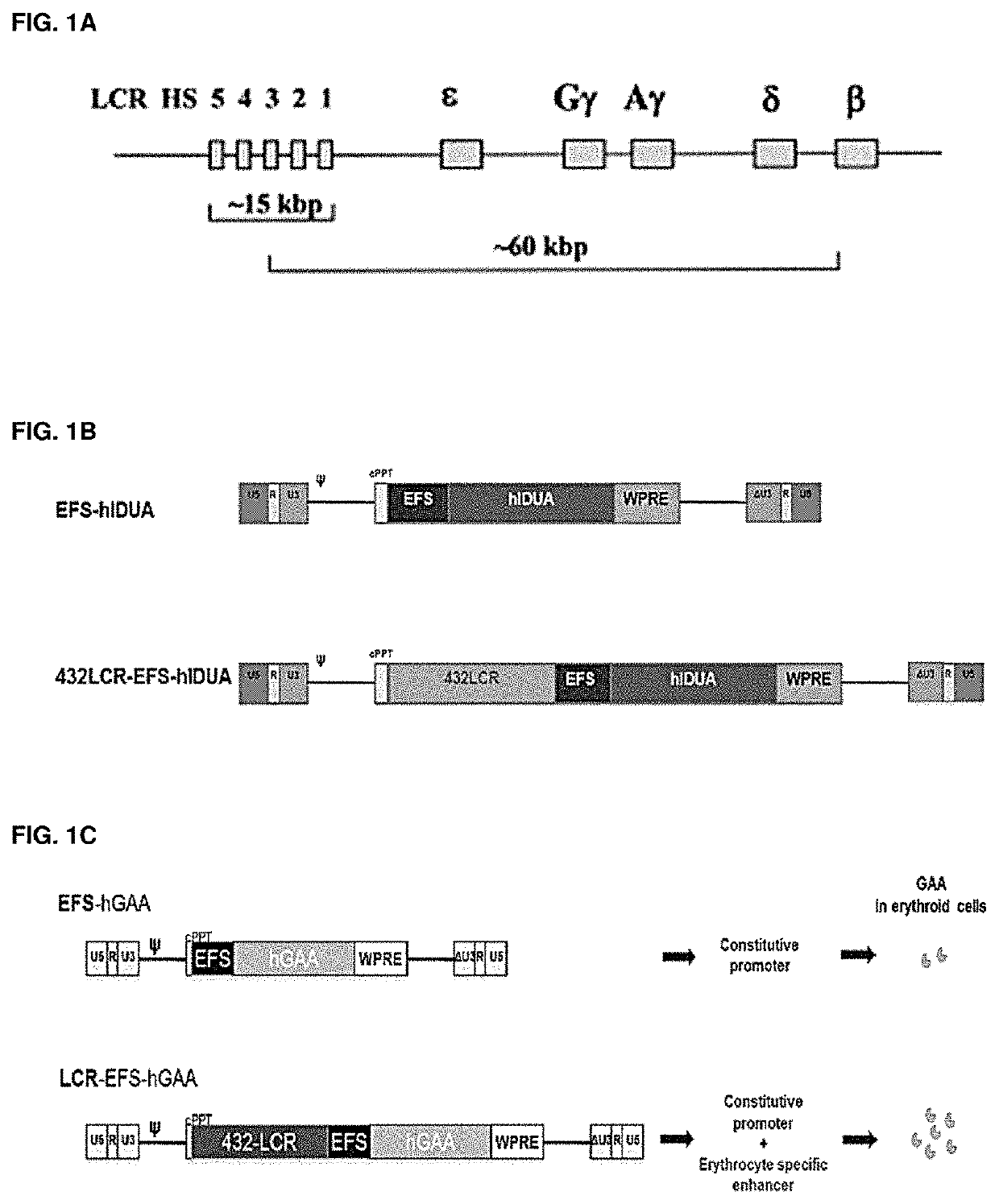Treatment of lysosomal storage diseases
- Summary
- Abstract
- Description
- Claims
- Application Information
AI Technical Summary
Benefits of technology
Problems solved by technology
Method used
Image
Examples
Example
Example 1
Enhancement of Expression of GFP and IDUA from a Lentiviral Vector
[0346]Experiments in C57BL / 6 mice transplanted with lineage negative (lin -ve) cells (hematopoietic progenitors) transduced with either the LV-βLCR-EFS-GFP (FIGS. 1A-1C) or the LV-EFS-GFP vector demonstrated that βLCR-EFS enhanced GFP expression by 20-fold in red blood cells in vivo without affecting expression in non-erythroid lineages, even one year after transplant (FIGS. 2A-2C).
[0347]Vectors were constructed in which the GFP reporter has been substituted for a codon optimised version of the human IDUA cDNA (FIG. 1A-1C). Experiments using these vectors in MEL cells again show upregulation of IDUA expression as a result of the bLCR containing vector (FIG. 3). We also performed an in vivo HSC transplant experiment (n=3) in IDUA− / − mice. It was shown that 12 weeks after transplant, the serum IDUA activity of mice receiving LV-bLCR-EFS-IDUA transduced HSCs was 40 times greater than the IDUA activity of mice re...
Example
Example 2
Functional Characterisation of IDUA Treated Animals
[0349]Macroscopic correction of the abnormal macrophage phenotype seen in the spleen of corrected mice in comparison to IDUA− / − or mock GFP-transduced mice was demonstrated by sectioning harvested spleens and staining with haematoxylin and eosin (H&E) (FIG. 6).
[0350]We have also quantified the level of total glycosaminoglycans (GAGs) in the liver and brain of these animals after treatment (FIGS. 5A and 5B). Animals in the HSCT, EFS and LCR EFS treatment groups all showed GAG levels comparable to WT in the liver. In the brain, all treatment groups had GAG levels similar to the untreated MPS-I mice. As the clearance of storage compounds in brain relies on the activity of IDUA-expressing microglia and turnover of precursors from the blood into the brain is a slow process, it is possible that 12 weeks post-transplant is still early to see differences between treatments. In addition, it is possible that in the gene therapy treat...
Example
Example 3
Biochemical Analysis of IDUA Transplanted Animals and Age-Matched Controls
[0351]The data generated here corresponds to the first transplant experiment (TP1), including a HSC transplant (HSCT) group (IDUA− / − receiving WT cells, n=2), a LCR-IDUA group (IDUA− / − receiving IDUA− / − cells transduced with the lentivirus β LCR-EFS-IDUA, n=5), a MPS-I group (IDUA− / − untreated n=4) and a WT group (WT untreated n=2). The group sizes for transplanted mice were larger at the start of the experiment (HSCT n=6 and LCR-IDUA n=7), but we lost some of the mice due to chemotherapy toxicity or lack of stem cell engraftment. We have refined the transplant procedure to avoid this issue.
[0352]Iduronidase activity has been measured in plasma and major organs of transplanted animals and compared to the levels observed in MPS-I and WT controls. In plasma (FIG. 7A), the levels of enzymatic activity are in average 100-fold higher in Gene Therapy animals in comparison to WT and HSCT controls, this is at...
PUM
 Login to View More
Login to View More Abstract
Description
Claims
Application Information
 Login to View More
Login to View More - Generate Ideas
- Intellectual Property
- Life Sciences
- Materials
- Tech Scout
- Unparalleled Data Quality
- Higher Quality Content
- 60% Fewer Hallucinations
Browse by: Latest US Patents, China's latest patents, Technical Efficacy Thesaurus, Application Domain, Technology Topic, Popular Technical Reports.
© 2025 PatSnap. All rights reserved.Legal|Privacy policy|Modern Slavery Act Transparency Statement|Sitemap|About US| Contact US: help@patsnap.com



